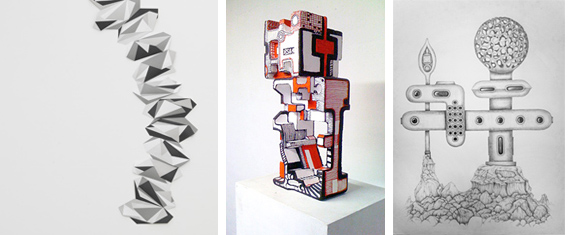Axis Mundi
Timothy Nolan
Jaime Scholnick
Osvaldo Trujillo
March 20 - April 18, 2010

CB1 Gallery presented Axis Mundi, featuring the work of Los Angeles artists, Timothy Nolan, Jaime Scholnick, and Osvaldo Trujillo. Appearing in many forms around the globe, the Axis Mundi takes shape in unique ways in the work of the three artists. The exhibition opened on March 20, 2010 and closed on April 18, 2010.
Timothy Nolan explores and interprets fundamental patterns, geometry, and systems-of- order which occur naturally and unnaturally, on purpose and by chance. While nearly everything we experience today is digitized, each convergence of shapes echoes back thousands of years through multiple iterations, revealing the building blocks of life and civilization. While Minimalism and Cubism have influenced Nolan’s work, he also draws inspiration from lesser-known movements such as Pattern and Decoration and Op Art, addressing shifting perception of two and three dimensions; illusionist (plastic) space vs. real dimensionality.
In Jaime Scholnick’s current series of works in Axis Mundi, on unadulterated Styrofoam, the artist plays with the hierarchical roles assigned to material goods, elevating a precisely machined material, formerly protection for a more significant object, into that which is now prized; the original object relegated to lesser status if not now garbage. Scholnick’s pieces are gesso-ed and drawn-on in a spontaneous manner, allowing the line to accentuate the form and create completely new spaces within the original, thus completing the transformation of the material into “art object.”
The drawings of Osvaldo Trujillo are mysteries, begun with a vision during a dream and elaborated upon by the artist, adding details that bring the image into focus for both the artist and the viewer. Structures of all kinds are the recurring subject in the work, some are architectural or anatomical or other broader systems—underlying forms of this world expressed in images of another. The works in Axis Mundi are derived from such deep and internal visual language that they are impossible to decipher.
BIBLIOGRAPHY